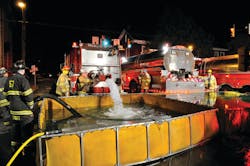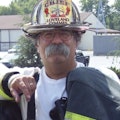On Wednesday, May 4, 2011, a four-alarm fire destroyed a 50-year-old bowling center in downtown Strasburg in Lancaster County, PA. The 180-by-200-foot, block building with a builtup flat roof was constructed in 1961. Later, in the mid-1970s, the flat roof, which was left in place, was covered with a bowstring truss roof that in turn was covered with rolled roofing material. There were no fire protection or detection systems in the building.
The Strasburg Fire Company and automatic mutual aid departments were dispatched to a reported structure fire at the Garden Spot Bowling Alley at 226 North Decatur St. at 9:16 P.M. Responding on the first alarm from Strasburg were Engine 5-10-1, Engine 5-10-2, Truck 5-10 (a 75-foot quint) and Tanker 5-10. Dispatched on mutual aid were Lafayette Fire Company Truck 6-3 (a 95-foot tower ladder); Ronks Fire Company Engine 4-8-2 and Heavy Rescue 4-8; Paradise-Lehman Place Fire Company Engine 4-7-2; Lampeter Fire Company Engine 5-4-2; and the Bird-in-Hand Fire Company Tanker 4-1. Fifty-four firefighters responded on the first alarm under the command of Strasburg Fire Chief Rick Wentz. Two employees and three customers evacuated the building before the arrival of the fire department.
First-arriving firefighters found attic space well involved and fire through the roof at the A/D corner. Strasburg Engine 5-10-2 laid a 300-foot, five-inch supply line from a hydrant at the A/D corner to the front of the building on side A. Strasburg Truck 5-10 was positioned at the A/B corner and set up for aerial master stream operations. Strasburg Engine 5-10-1 hooked onto a hydrant on the A/D corner with a five-inch supply line and pumped to Strasburg Engine 5-10-2. Three firefighters from Strasburg Truck 5-10 advanced a 250-foot, 2½-inch line through the front door from Strasburg Engine 5-10-2.
Quick Retreat
After making entry, the crew reported dark smoke banked down to within five feet of the floor. Firefighters could initially see the entire length of the building to the end of the bowling alleys where the pin setters were located. Within seconds, the smoke dropped to the floor and the temperature rose quickly with small fingers of flames rolling through the smoke. The crew immediately retreated to the outside of the building. Firefighters placed two 200-foot, 1¾-inch lines into operation on side A from Strasburg Engine 5-10-2. Strasburg Tanker 5-10 and Bird-in-Hand Tanker 4-1 were positioned in front of Engine 5-10-2 and provided water until the hydrant supply line was operational. Ronks Engine 4-8-2 took a position on side A and Ronks Rescue 4-8 was placed in a parking lot across from the A side of the building.
Wentz requested a second alarm at 9:21 P.M. Paradise-Leham Place Engine 4-7-1, Bart Township Fire Company Engine 5-1-1, Lampeter Engine 5-4-1 and Ronks Air Unit 4-8 responded with 22 firefighters.
Going on the Defensive
Wentz ordered defensive operations initiated at 9:30 P.M. Strasburg Truck 5-10 was supplied by a 100-foot, five-inch line from Strasburg Engine 5-10-2 for aerial master stream operations. Lafayette Truck 6-3 was set up for aerial master stream operations at the A/D corner. A second hydrant on the municipal water system at Pleasant View Drive and Clark Avenue was used. Firefighters hand-laid 300 feet of five-inch line from Ronks Engine 4-8-2 to the hydrant. Ronks Engine 4-8-2 supplied Lafayette Truck 6-3 with a 200-foot, five-inch line for master stream operations.
A 55-plus retirement community was on side C. Bart Township Engine 5-1-1 was assigned to operations on the C side of the fire building. Engine 5-1-1 was positioned in the parking lot of the retirement community and hooked onto a hydrant with a five-inch supply line. Firefighters placed several 1¾-inch lines in operation along with a three-inch line on side C. Exposures on side D included a dental office and a doctor’s office within 60 feet of the fire building. Lampeter Engines 5-4-1, 5-4-2 and 5-4-3 were assigned to these exposures. Crews operated several 1¾-inch lines to protect the exposures. Engine 5-4-1 also supplied a three-inch line on side D of the fire building. Pieces of debris were found a half-mile away.
At 9:32, a special request was made for a task force of 10 tankers. Responding tankers included Refton Fire Company Tanker 5-9, West Willow Fire Company Tanker, Intercourse Fire Company Tanker 4-4, Bart Township Tanker 5-1-1 and Tanker 5-1-2, Witmer Fire Company Engine 4-10-2 and Tanker 4-10 and Kinzer Fire Company Tanker 4-5. Also making up the task force were Strasburg Tanker 5-10 and Bird-in-Hand Tanker 4-1, which responded on the initial alarm. The tankers were assigned to the south side of the fire.
Wentz requested a third alarm at 9:55 P.M. Gap Fire Company Truck 4-2 (a 100-foot aerial), Quarryville Fire Company Truck 5-7 (a 95-foot aerial), and White Horse Fire Company Tanker 4-9, New Danville Fire Company Tanker 5-5, Rawlinsville Fire Company Tanker 5-8 and Christiana Fire Company Tanker 5-2-1 responded with 22 firefighters. Gap Truck 4-2 was positioned at the B/C corner and set up for aerial master stream operations.
Command made several requests for additional apparatus and manpower. Seventy-three firefighters responded with Gordonville Fire and Ambulance Association Engine 4-3-1 and Hose 4-3, Bart Township Engine 5-1-1, Lampeter Engine 5-4-3, Witmer Engine 4-10-2, Lafayette Engines 6-3-1, 6-3-2 and 6-3-3, Refton Engine 5-9-1, Willow Street Fire Company Engine 5-12-2, Quarryville Engine 5-7-2, Ronks Engine 4-10-1, Cochranville Fire Company from Chester County Engine/Tanker 27-5, Kinzer Engine 4-5-2 and Conestoga Fire Company Engine 5-3-2. Multiple other departments provided standby coverage.
A tanker shuttle was established on the south side of the fire at 9:59 P.M. Two 1,600-foot, five-inch lines were laid from the Square of Strasburg Borough (the intersection of North Decatur and East Main streets) to the fire scene. One supply line was laid by Refton Engine 5-9-1 and completed by Gordonville Hose 4-3. The second line was laid by Kinzer Engine 4-5-2 and completed by Gordonville Hose 4-3. One line supplied Lampeter Engine 5-4-1 and the second line supplied Lampeter Engine 5-4-2, both operating on exposure operations. Two 3,000-gallon portable tanks were placed at the dump site. Gordonville Tanker 4-3 was set up for drafting at the dump site and supplied Lampeter Engines 5-4-1 and 5-4-2. Eleven tankers were assigned to this operation with a fill site established at the borough pond a half-mile from the Square. Willow Street Engine 5-12-2 and Kinzer Engine 4-5-2 established drafting operations at the fill site. At 10:12, commanders determined additional water would be needed to support firefighting operations. This required the establishment of a fill site, dump site and tanker shuttle on the north side of the fire.
Bird-in-Hand Tanker 4-1 laid 600 feet of five-inch line north from the fire scene to Route 896 and Historic Drive. Two 3,000-gallon portable tanks were set up at the dump site. Gordonville Hose 4-3 set up for drafting at the dump site and fed Lafayette Engine 6-3-2, which supplied Gap Truck 4-2 with a 200-foot, five-inch line. Witmer Engine 4-10-1 and Conestoga Engine 5-3-2 established drafting operations at the fill site on Route 896 at the Conestoga River, a mile north of the dump site. Thirteen tankers were requested for this operation: Intercourse Tanker 4-4, Witmer Tanker 4-10, Kinzer Tanker 4-5, White Horse Tanker 4-9, New Danville Tanker 5-5, Neffsville Fire Company Tanker 207, Manheim Fire Company Tanker 2-6, Penryn Fire Company Tanker 2-8, Blue Ball Fire Company Tanker 3-2, Cochranville Fire Company Engine/Tanker 27-5, East Hempfield Township Fire Company Tanker 7-19 and Blue Rock Fire Rescue Tanker 907 and Tanker 903. The operation required a continuous flow of 4,500 gpm.
Wentz declared the fire under control at 11:41 P.M. Strasburg Truck 5-10 was the last unit to leave the scene at 3:08 A.M. on May 5. The department was recalled to the scene three times on May 5 to extinguish flare-ups in the rubble. Investigators determined the damage was too extensive to identify a specific cause.
Problems
Problems encountered included:
• Delayed notification of the fire to the fire department. During interviews, employees of the business reported smelling smoke an hour before they saw smoke coming from the HVAC vents.
• Water supply. The municipal water system was quickly overtaxed by the use of master streams. The hydrants used for water supply were on an eight-inch main.
• Overhead electric lines. High-voltage electric lines ran in front of the building on the A side, which prevented safe setup of aerial operations. The power company had to drop the entire grid to make it safe for operations. This dropped the power to the water well pumps at the reservoir for the hydrant system. The power company was never able to properly ground the wires to ensure all the power was off.
• Communications. Water-supply operations were assigned to a radio frequency used for siren activation, causing disruption of communications.
Successes
Among the successes noted were:
• Water supply. Knowing the limited supply on the municipal water system, command established two tanker shuttles.
• Pre-planning. Numerous tours of the building gave firefighters a thorough understanding of the construction and what challenges they faced. The possibility of an early collapse of the bowstring truss roof over the flat roof and the limited water supply were among the challenges identified.
• Knowledge of the signs of backdraft and flashover. Firefighters identified signs of potential flashover and exited the building. The building flashed over in minutes.
• Rural water supply training. Drills have been conducted to develop the best methods of moving large volumes of water over extended periods.
About the Author
Billy Goldfeder
BILLY GOLDFEDER, EFO, who is a Firehouse contributing editor, has been a firefighter since 1973 and a chief officer since 1982. He is deputy fire chief of the Loveland-Symmes Fire Department in Ohio, which is an ISO Class 1, CPSE and CAAS-accredited department. Goldfeder has served on numerous NFPA and International Association of Fire Chiefs (IAFC) committees. He is on the board of directors of the IAFC Safety, Health and Survival Section and the National Fallen Firefighters Foundation.

